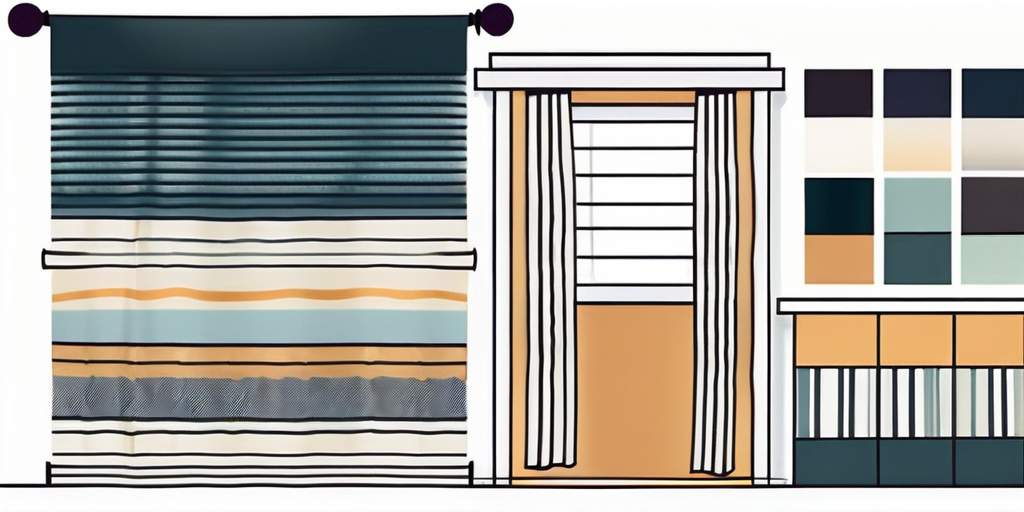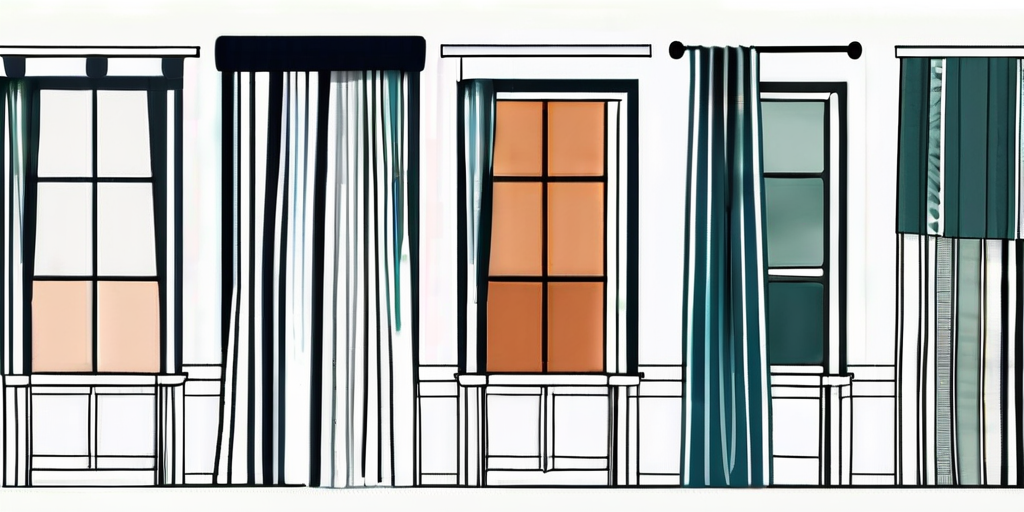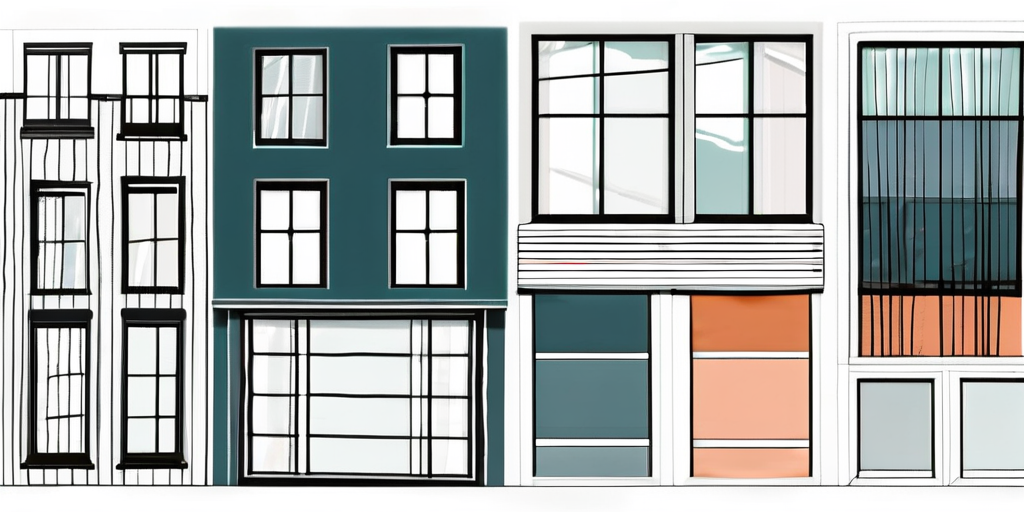Window treatments play a crucial role in enhancing the overall look and feel of a room. When it comes to coordinating blinds and shades with other window treatments, there are a few key factors to consider. Understanding the basics of window treatments, choosing the right color palette, balancing functionality and aesthetics, and mixing and matching different window treatments are all important aspects to achieve a cohesive and stylish look in your space. In this article, we'll explore these topics in more detail, providing you with valuable tips and advice to help you create the perfect window treatment combination for your home.
Understanding the Basics of Window Treatments
Before delving into the specifics of coordinating blinds and shades, it's important to have a solid understanding of the basics of window treatments. Blinds and shades, although similar in function, have distinct roles in window treatments.

Window treatments play a crucial role in interior design, not only for their functionality but also for their aesthetic appeal. They can enhance the overall look of a room, tying together different design elements and creating a cohesive atmosphere. When choosing window treatments, it's essential to consider factors such as the room's purpose, the amount of natural light it receives, and the desired level of privacy.
The Role of Blinds in Window Treatments
Blinds are versatile and practical window coverings, perfect for enhancing any space. At Gallery Window Fashions, we understand the importance of both style and functionality in your home decor. That's why our blinds offer precise control over privacy and light levels, allowing you to adjust the slats to your desired position effortlessly. Crafted from quality materials such as aluminum, wood, or faux wood, our blinds come in various styles, including horizontal or vertical designs.
One of the key advantages of Gallery Window Fashions blinds is their ability to complement a modern and minimalist aesthetic. Their clean lines and simple design make them a popular choice for contemporary interiors. Additionally, our blinds are easy to maintain and clean, ensuring they remain looking fresh and stylish for years to come. Choose Gallery Window Fashions for window coverings that combine practicality with timeless elegance.
The Function of Shades in Window Treatments
Shades, on the other hand, are window coverings made of fabric or woven materials. They come in different styles, such as roller shades, Roman shades, and cellular shades. Shades are great for adding texture and softness to a space, while also providing light filtering or room-darkening capabilities.
Unlike blinds, shades have a softer appearance and can add a touch of elegance to a room. They are available in a wide range of colors, patterns, and textures, allowing for more design versatility. Shades are also known for their energy-efficient properties, helping to insulate windows and regulate indoor temperatures.
Choosing the Right Color Palette for Your Window Treatments
One crucial element in coordinating blinds and shades with other window treatments is choosing the right color palette. The color of your window treatments can significantly impact the overall ambiance of the room. Here are two key considerations to keep in mind when selecting colors:
Matching Blinds and Shades with Wall Colors
To create a harmonious and cohesive look, consider choosing blinds and shades that complement the wall colors in your room. If your walls are painted in a neutral tone, you have more flexibility to experiment with bolder shades or patterned blinds. On the other hand, if your walls feature vibrant or bold colors, it's often best to opt for more subtle window treatments.
When selecting colors for your window treatments, it's essential to consider the natural light that enters the room. Rooms with ample natural light can handle darker or more saturated colors without feeling too heavy. In contrast, rooms with limited natural light may benefit from lighter-colored window treatments to help brighten the space.
Complementing Furniture with Window Treatments
Another factor to consider is how your blinds and shades will coordinate with your existing furniture. If your furniture pieces have intricate patterns or bold colors, opting for neutral or solid-colored window treatments can help create a balanced and visually appealing space. On the flip side, if your furniture is more minimalistic, incorporating patterned or textured blinds and shades can add visual interest.
Consider the overall style of your room when choosing colors for your window treatments. For a modern and sleek look, monochromatic color schemes can create a sense of sophistication. In contrast, mixing complementary colors can add a playful and dynamic touch to a more eclectic or bohemian-inspired space.
Balancing Functionality and Aesthetics
When coordinating blinds and shades with other window treatments, it's essential to strike a balance between functionality and aesthetics. Here's what to consider:
Considering Light Control and Privacy
Assessing your needs for light control and privacy is vital in selecting the right window treatments. Blinds, with their adjustable slats, provide excellent control over both light and privacy. If you require more diffused light or want to filter out harsh sunlight, shades can be an ideal choice. For areas like bedrooms or bathrooms, where privacy is a priority, consider adding blackout blinds or room-darkening shades.
Moreover, when thinking about light control, consider the direction your windows face. Rooms that receive direct sunlight may benefit from light-filtering shades to reduce glare and protect furniture from UV damage. On the other hand, rooms that need maximum privacy, such as ground-level spaces, might require top-down bottom-up blinds for a perfect balance of light and seclusion.
Prioritizing Style and Design
In addition to functionality, style and design should also be a top consideration. Blinds and shades come in a wide range of materials, patterns, and colors. Consider the overall style of your room, whether it's modern, traditional, or somewhere in between. Choose window treatments that complement the existing decor and contribute to the overall aesthetic.
Furthermore, don't forget to think about the visual weight of your window treatments. Heavier fabrics and darker colors can add a sense of coziness and intimacy to a room, while lighter materials and neutral tones can create an airy and spacious feel. Mixing and matching different textures and patterns can also add depth and visual interest to your space, making your blinds and shades not just functional but also a design statement.
Mixing and Matching Different Window Treatments
If you're feeling adventurous, mixing and matching different window treatments can add depth and visual interest to your space. Here are some ideas:

Pairing Blinds with Curtains
One popular combination is pairing blinds with curtains. This combination offers both functionality and style. The blinds provide light control and privacy while the curtains add a touch of elegance and softness. When choosing curtains, consider their color and fabric to ensure they coordinate well with the blinds.
Blinds come in various materials such as wood, faux wood, aluminum, or fabric. Depending on the style of your space, you can choose the type of blinds that best complement your decor. For a more modern look, sleek aluminum blinds might be the perfect choice, while wooden blinds can add warmth and a natural element to a room.
Combining Shades with Drapes
For a more layered and luxurious look, consider combining shades with drapes. Shades can provide light filtering or room-darkening capabilities, while drapes add an additional layer of texture and style. This combination works particularly well in living rooms and dining areas, where you want to create a more formal and sophisticated ambiance.
When selecting shades, think about the level of privacy and light control you need in each room. Cellular or honeycomb shades are great for insulation and energy efficiency, while Roman shades offer a classic and elegant look. Pairing these shades with floor-to-ceiling drapes can create a dramatic effect and make your windows a focal point in the room.
Tips for Coordinating Blinds and Shades
When it comes to coordinating blinds and shades with other window treatments, there are a few key factors to consider. Let's dive deeper into these tips to help you make the best choices for your space.

Selecting the Right Material
One of the most important considerations when choosing blinds and shades is the material. Each material has its own unique characteristics that can greatly impact the overall look and feel of your space. For example, if you're aiming for a natural and warm atmosphere, wooden blinds or bamboo shades can be an excellent choice. These materials not only add a touch of elegance but also provide excellent light-filtering properties.
On the other hand, if you're going for a more modern and sleek look, aluminum blinds or cellular shades might be the way to go. These options offer a clean and minimalist aesthetic that can effortlessly complement contemporary interior designs.
Considering the Room's Purpose and Style
Another crucial factor to keep in mind is the purpose and style of the room where you'll be installing the blinds and shades. Different rooms have different needs, and understanding these needs will help you make the right decisions.
For instance, in a home office, privacy and light control are often top priorities. You want to create an environment that allows you to focus without distractions. In this case, consider opting for blinds or shades that offer excellent privacy features, such as blackout options or top-down/bottom-up functionality.
On the other hand, in a living room, you may be more focused on creating a welcoming and cozy atmosphere. Here, you can play with different textures and patterns to add visual interest to your windows. Consider layering curtains or drapes over your blinds or shades to create a luxurious and inviting look.
By carefully considering the purpose and style of each room, you can select window treatments that not only enhance the overall aesthetic but also cater to the specific needs of the space.
Remember, coordinating blinds and shades with other window treatments is an essential aspect of interior design. By understanding the basics of window treatments, choosing the right color palette, balancing functionality and aesthetics, and experimenting with different combinations, you can create a harmonious and visually appealing space.
So, take the time to assess your needs for light control and privacy, consider the style and design of your room, and select materials that fit your desired look and feel. With these tips in mind, you'll be well-equipped to create a stunning and cohesive window treatment arrangement in your home.

No comments yet